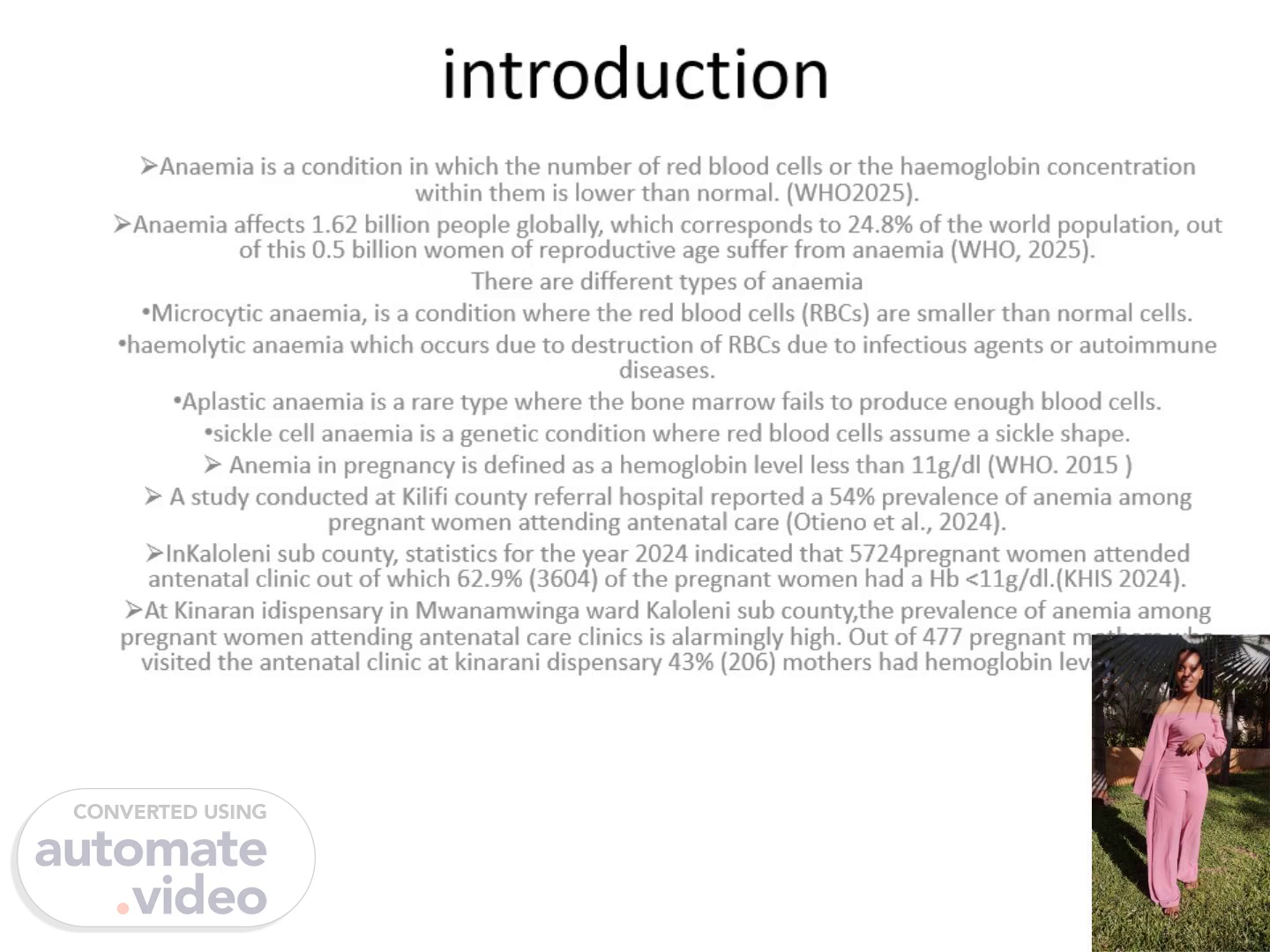Scene 1 (0s)
introduction. Anaemia is a condition in which the number of red blood cells or the haemoglobin concentration within them is lower than normal. (WHO2025). Anaemia affects 1.62 billion people globally, which corresponds to 24.8% of the world population, out of this 0.5 billion women of reproductive age suffer from anaemia (WHO, 2025). There are different types of anaemia Microcytic anaemia, is a condition where the red blood cells (RBCs) are smaller than normal cells. haemolytic anaemia which occurs due to destruction of RBCs due to infectious agents or autoimmune diseases. Aplastic anaemia is a rare type where the bone marrow fails to produce enough blood cells. sickle cell anaemia is a genetic condition where red blood cells assume a sickle shape. Anemia in pregnancy is defined as a hemoglobin level less than 11g/dl (WHO. 2015 ) A study conducted at Kilifi county referral hospital reported a 54% prevalence of anemia among pregnant women attending antenatal care (Otieno et al., 2024). InKaloleni sub county, statistics for the year 2024 indicated that 5724pregnant women attended antenatal clinic out of which 62.9% (3604) of the pregnant women had a Hb <11g/dl.(KHIS 2024). At Kinaran idispensary in Mwanamwinga ward Kaloleni sub county,the prevalence of anemia among pregnant women attending antenatal care clinics is alarmingly high. Out of 477 pregnant mothers who visited the antenatal clinic at kinarani dispensary 43% (206) mothers had hemoglobin levels of less.
Scene 2 (1m 18s)
[Audio] The prevalence of anaemia among pregnant women in Kenya is 55.1 percent. Anaemia is a significant public health concern because it is a major cause of morbidity and mortality in pregnant women, increasing the risk of foetal, neonatal, and overall infant mortality. Notably, the rate of anemia among pregnant women attending antenatal care at Kinarani Dispensary in Mwanamwinga Ward, Kaloleni Sub-county, is particularly high, with 206 out of 477 expectant mothers having hemoglobin levels below 11g/dl..
Scene 3 (1m 57s)
[Audio] The objectives of this study are multifaceted. We aim to identify the factors associated with anemia among pregnant women attending the antenatal clinic at Kinarani dispensary, Mwanamwinga ward. This will help us understand the underlying causes of anemia in this population. We also seek to determine the socioeconomic characteristics of pregnant women attending ANC at Kinarani dispensary. This will provide valuable insights into the demographic and social profiles of these women. Furthermore, we aim to determine the prevalence of anemia among pregnant women attending antenatal care clinics at Kinarani dispensary. This will give us an idea of the scope of the problem in this specific setting. Lastly, we hope to identify the factors associated with anemia among pregnant women attending ANC at Kinarani dispensary. By doing so, we can develop targeted interventions to address this public health issue..
Scene 4 (2m 58s)
[Audio] The research questions are threefold. We seek to understand the socio-economic characteristics of pregnant women attending ANC clinics at Kinarani dispensary, including their demographic information, education level, occupation, marital status, and other relevant socio-economic factors. We also aim to determine the prevalence of anaemia among pregnant women attending antenatal clinics at Kinarani dispensary by identifying the proportion of pregnant women who have haemoglobin levels below 11g/dl. Furthermore, we want to identify the factors associated with anaemia among pregnant women attending ANC at Kinarani dispensary, which may include socio-economic variables, as well as others such as age, parity, and previous history of anaemia..
Scene 5 (3m 49s)
[Audio] The study aims to identify factors associated with anemia among pregnant women attending the antenatal clinic at Kinarani dispensary, Mwanamwinga ward, to determine the socioeconomic characteristics of pregnant women attending ANC at Kinarani dispensary, to determine the prevalence of anemia among pregnant women attending antenatal care clinics at Kinarani dispensary, and to identify the factors associated with anemia among pregnant women attending ANC at Kinarani dispensary. The study will employ a descriptive cross-sectional study design, collecting both qualitative and quantitative data from pregnant women who visit Kinarani Dispensary. The study area is located in Mwanamwinga ward, Kaloleni sub-county, Kilifi County, with an approximate population of 13,497 people. The study population consists of pregnant women residing in the Kinarani community and those who visit Kinarani Dispensary. Data will be analyzed using descriptive statistics, including measures of central tendency, frequencies, and percentages..
